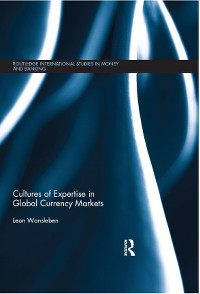
 Cultures of Expertise in Global Currency Markets is definitely not some average Forex trading book you read to get the basic understanding of the market or to learn a handful of new strategies. This book is an attempt to explain what is going on with the biggest participants of the FX market from the sociological rather than economical point of view.
Cultures of Expertise in Global Currency Markets is definitely not some average Forex trading book you read to get the basic understanding of the market or to learn a handful of new strategies. This book is an attempt to explain what is going on with the biggest participants of the FX market from the sociological rather than economical point of view.
The book was published quite recently (in July 2013) and lacked any reviews when I first turned my attention to it. Its abstract had gave me an impression of a rather nonstandard approach to the description of the foreign exchange market and I decided to buy the book despite the very high price for something without positive reviews (more than $100 for Kindle version in November 2013). Now I can positively say that I do not regret the purchase and the time I have spent crawling through the scientific lingo of the Cultures.
Contents
- 1 The Author
-
2 Sociology of Forex
- 2.1 The History of Forex Cultures of Knowledge
- 2.2 Trading Floor — Analysis and Forecast
-
3 Pros and Cons
- 3.1 Advantages
- 3.2 Disadvantages
- 4 Technicalities
- 5 Conclusion
The Author
Cultures of Expertise in Global Currency was written by Leon Wansleben, a Swiss sociologist who gained his PhD at the University of Konstanz and is currently conducting his research at the University of Konstanz. He specializes in a study of the economic and financial analysis practices.
There is not much info on him besides that, but I must say that for a
Sociology of Forex
Although the author divides the book into three structural parts, I would say that it consists of two main parts. The first is a general introduction into the history of the global currency markets. The second part is the description and results of the field study conducted by Leon on a the FX trading floor of a big German bank (supposedly Commerzbank). Additional parallels with other research from the similar studies are drawn to reinforce or provide alternative judgements to the author’s. The conclusion is given to wrap the whole research up and provide directions for further investigation of the Forex markets’ ethnography.
The History of Forex Cultures of Knowledge
Wansleben retells the history of the market’s structure (divided by him into three major stages) to explain how the participants, their interaction and distribution of expertise among them changed with the technological and public progress. Here I try to name the things that an active trader can learn from the first part of the book:
Trading Floor — Analysis and Forecast
The second part is, of course, more interesting than the first one. It describes how the real Forex trading floor is working at a bank. Actually, at two banks as the second bank (supposedly Dresdner Bank) is acquired by the first one during the course of the author’s field study. Surely, I would expect the author to leave some proprietary things out of the published book, but nevertheless the amount of information rarely available to retail traders is huge.
Leon Wansleben gives an exhaustive description of the physical structure of the floor, its schedule, its interaction schemes and a lot more. You literally learn how analysis, forecast and trading is performed by both the
Here is what I learned from this part:
Pros and Cons
I will try to briefly list the advantages and disadvantages of this book. The main problem here is that the list is largely subjective and should be interpreted as something very opinionated.
Advantages
Disadvantages
Technicalities
Cultures of Expertise in Global Currency Markets is available in hardcover and Kindle format. I have read the Kindle version. The quality of this particular Kindle edition is above average. There are no 90° rotated charts, and those few images it features are very clear. The only technical problem I have encountered was an unlinked reference (8th) in the last chapter of the book.
Conclusion
The bottom line is pretty simple — if you are seeking to elevate your level of understanding of the big market participants and to improve your own organizational level, this book can be a nice choice for you. On the other hand, if you are easily bored with scientific jargon, or if you are already well aware of the situation within the currency trading banks, you probably will not gain anything useful from Cultures of Expertise in Global Currency Markets.
Anyway, the book does not look as if it was intended to be read by the majority of traders. Its likely target audience is other sociologists and scholars of the market’s structure, history and psychology.
If you have any questions, comments or opinions about Cultures of Expertise in Global Currency Markets by Leon Wansleben, please feel free to submit them using the commentary form below.